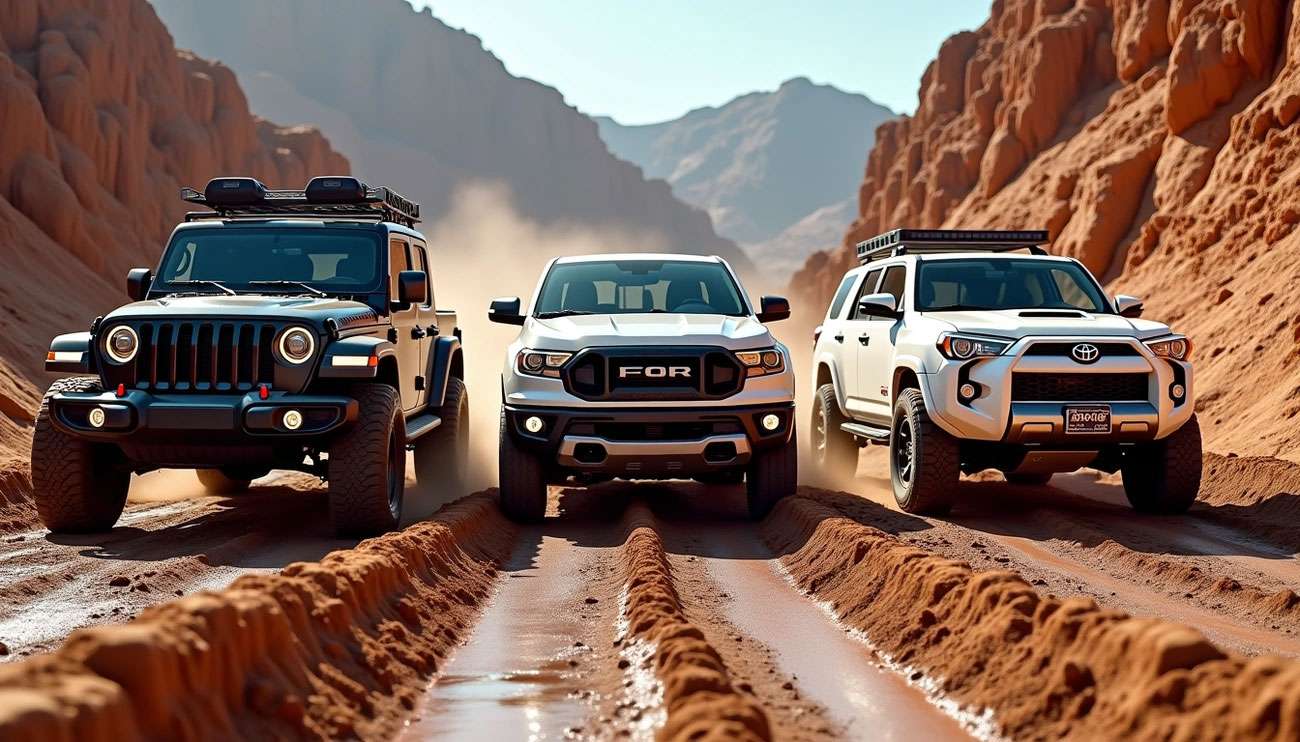
Getting stuck in mud or losing traction on rocks because you chose the wrong off road tires can turn your adventure into a nightmare. The right rubber makes all the difference between conquering challenging terrain and calling for help.
Off-road tires are engineered with deep, aggressive treads specifically designed to grip unpaved surfaces like loose dirt, mud, sand, and gravel. These specialized tires deliver the traction you need when standard highway tires simply can't handle the terrain.
We understand that choosing the right off-road tire can be overwhelming with so many options available. Three primary categories dominate the off-road tire market: All-Terrain (A/T), Mud-Terrain (M/T), and Rugged Terrain (R/T) tires. Each category serves different driving needs and terrain challenges.
All-terrain tires provide balanced performance across multiple surfaces, from dirt trails to paved highways. Mud-terrain tires excel in extreme conditions, delivering maximum traction through mud, rocks, and challenging terrain. Rugged terrain tires bridge the gap between these options, offering aggressive capability with improved on-road manners.
At Performance Plus Tire, we've tested different tire types across various terrains to help you make informed decisions. This guide breaks down all eight types of off-road tires, giving you the knowledge needed to select the perfect match for your 4x4 adventures in 2025.
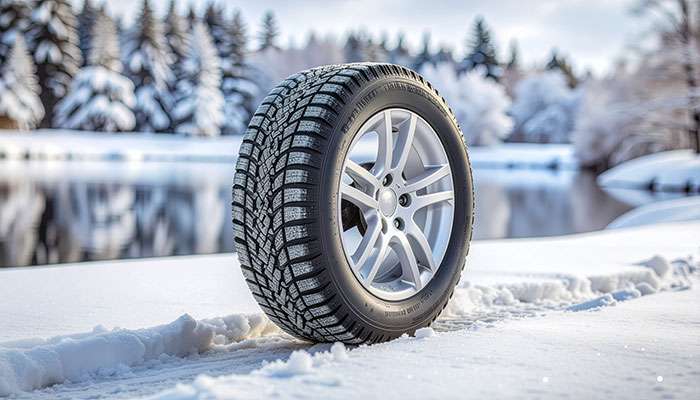
All-terrain tires represent the most versatile option in the off-road tire market. These balanced performers deliver solid off-road capability without sacrificing everyday driving comfort, making them the go-to choice for drivers who need one tire solution for multiple driving environments.
All-terrain tires feature a carefully engineered hybrid tread design that sits between aggressive mud-terrain patterns and smooth highway treads. The open-tread pattern provides excellent grip on varied surfaces while maintaining acceptable on-road manners.
Quality all-terrain tires deliver several key performance features:
Reinforced sidewalls that resist punctures and provide enhanced durability when driving over sharp rocks or rough terrain
Interlocking tread elements that deliver superior grip on rocks and mud
All-season capability with many models carrying the three-peak mountain snowflake symbol (3PMSF) for winter performance
Large, deep lugs for better grip on loose surfaces, though with tighter patterns than mud-terrain options
The tread compound used in all-terrain tires is typically firmer than mud-terrain alternatives, contributing to their longer tread life ranging from 45,000-65,000 miles before replacement. This durability makes them an excellent value proposition for drivers seeking long-term performance.
Pros:
Versatility across multiple terrains and conditions
Superior traction in wet, slippery, and light off-road conditions
Longer tread life than mud-terrain options
Better fuel efficiency compared to more aggressive off-road tires
Rugged, aggressive appearance that enhances vehicle esthetics
Cons:
Noisier on highways than standard road tires
Stiffer ride quality that can reduce overall comfort
Higher price point than standard highway tires
Less capable in extreme off-road conditions than specialized mud or rock tires
Increased rolling resistance that may reduce fuel economy by approximately 1 MPG compared to highway tires
All-terrain tires typically range from $200-$400 per tire depending on size, brand, and load rating. This pricing positions them as more affordable than mud-terrain options, which typically cost $50 more per tire.
Premium options like the BFGoodrich All-Terrain T/A KO2 and Toyo Open Country A/T III offer excellent value in the mid to upper price range, delivering the best balance of performance and longevity. Budget-conscious drivers can find entry-level all-terrain options from brands like Kelly, Firestone, and Nitto starting around $50 per tire.
All-terrain tires excel for drivers who split their time approximately 60% on-road and 40% off-road. These tires are particularly well-suited for:
Light trucks and SUVs that regularly transition between highway driving and off-road trails
Daily drivers that occasionally venture off-pavement for camping, hiking, or outdoor activities
Regions with variable weather including rain, light snow, and moderate mud
Pickup trucks carrying moderate loads on both paved and unpaved surfaces
4x4 vehicles that need reliable performance across changing terrains without sacrificing highway comfort
These tires provide the perfect solution for weekend adventurers who refuse to compromise everyday driving comfort but need the confidence to tackle forest service roads, gravel paths, and light trails. Their improved wet weather performance makes them a practical year-round choice, eliminating the need for seasonal tire changes except in the most severe winter conditions.
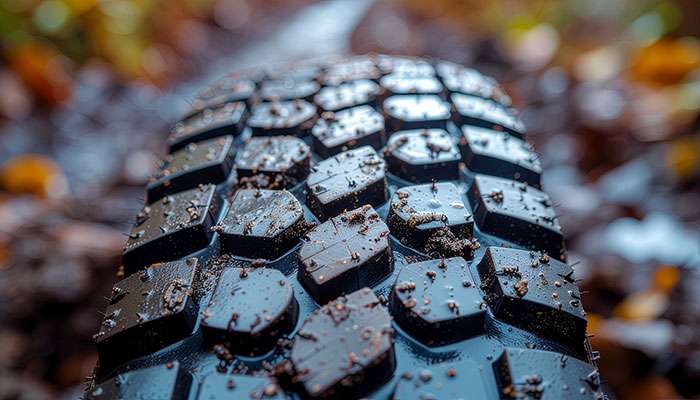
Serious off-road enthusiasts know that when the terrain gets tough, mud-terrain (M/T) tires deliver unmatched performance where other tires fail. These specialized tires are engineered specifically for conquering extreme conditions, prioritizing maximum off-road capability over on-road comfort.
Aggressive tread patterns define M/T tires, featuring fewer but larger tread lugs with substantial spacing between them. This design excels at self-cleaning, effectively ejecting mud, rocks, and debris to maintain traction. The pattern extends to the sidewall with "side bites" that provide additional grip when navigating deep ruts or steep angles.
Quality mud-terrain tires incorporate several advanced design elements:
Deep, aggressive lugs with wide spacing that maintain forward momentum in soft terrain
"Mud-Phobic" bars strategically placed on tire shoulders to release compacted mud
Reinforced sidewalls featuring 3-ply or higher construction for superior puncture resistance
Softer rubber compounds that enhance grip on rocks and slick surfaces
Tread depth in quality mud-terrain tires ranges from 12mm to 17mm, significantly deeper than other tire categories. Combined with "Terrain-Attack" tread patterns, this depth delivers exceptional grip from any approach angle.
Pros:
Exceptional traction in mud, dirt, sand, and rocky terrain
Superior self-cleaning capabilities that prevent tread clogging
Enhanced puncture resistance from reinforced sidewall construction
Increased ground clearance for lifted vehicles
Ability to run at low air pressure for improved traction in extreme conditions
Cons:
Significantly noisier on paved roads due to aggressive tread design
Reduced fuel efficiency, approximately 1 MPG less than all-terrain options
Shorter tread life, averaging 35,000-45,000 miles compared to 45,000-65,000 for A/T tires
Poor wet pavement performance in rainy conditions
Less effective in cold weather conditions
Poor braking performance on pavement
M/T tires represent a premium investment, typically costing $300-$500 per tire depending on size, brand, and load rating. This premium positions them approximately $50 more per tire than comparable all-terrain options.
Major brands in the mud-terrain category include BFGoodrich, Toyo, Nitto, Mickey Thompson, and Falken. Popular models like the BFGoodrich Mud-Terrain T/A KM3 and Toyo Open Country M/T command premium prices, starting around $450-$500 per tire.
Mud-terrain tires excel when maximum off-road capability outweighs on-road comfort considerations. They're specifically designed for:
Vehicles spending 50% or more of their time off-road
Rock crawling and extreme terrain navigation
Deep mud, loose gravel, and sandy environments
Lifted 4x4s requiring additional ground clearance
Off-road competition and dedicated trail rigs
M/T tires remain specialists rather than generalists. While modern engineering has improved their on-road behavior, they're best suited for enthusiasts who prioritize off-road performance above everyday driving comfort. These tires deliver when the terrain demands maximum traction and durability.
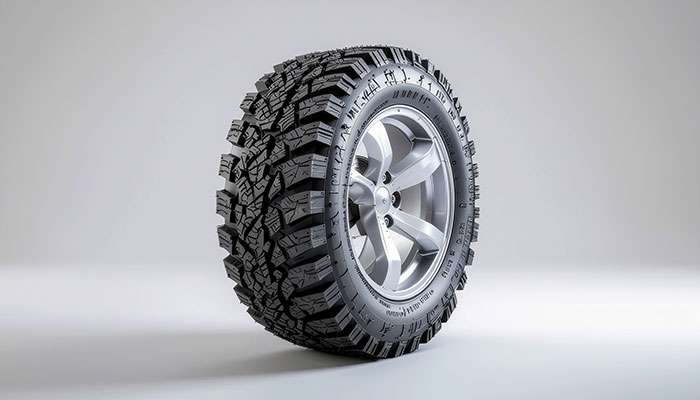
Rugged terrain tires (R/T) represent the newest evolution in off-road tire technology, filling a crucial gap that many drivers didn't even know existed. These innovative tires solve the age-old problem of choosing between all-terrain versatility and mud-terrain aggression by combining the best characteristics of both categories.
The engineering behind R/T tires focuses on strategic compromise rather than extreme specialization. Where all-terrain tires prioritize highway comfort and mud-terrain tires maximize off-road grip, rugged terrain options optimize the balance between these competing demands.
The tread architecture features larger, more open blocks than you'll find on A/T tires, yet maintains tighter spacing compared to full mud-terrain alternatives. This design creates enhanced self-cleaning capabilities that help eliminate mud, snow, and rocks from between tread elements, while the aggressive shoulder lugs provide additional traction in soft terrain and aid mud evacuation.
Construction quality sets R/T tires apart through reinforced sidewalls with 3-ply construction for superior puncture resistance. Many models incorporate specialized technologies like "Tectonic tread blocks" that minimize block squirm and enhance stability during heavy towing applications. The widest tread patterns among the three primary off-road categories make these tires particularly valuable for trucks and SUVs handling significant loads.
Rugged terrain tires deliver enhanced off-road traction compared to all-terrain options while maintaining quieter highway performance than mud-terrain alternatives. The reinforced construction resists cuts and damage better than lighter-duty options, and many models carry Three-Peak Mountain Snowflake certification for reliable winter performance.
However, the deeper, more aggressive tread reduces fuel efficiency compared to all-terrain tires. While capable in challenging conditions, R/T tires don't quite match dedicated M/T options in extreme mud scenarios. They typically produce more road noise than all-terrain alternatives and command higher prices than entry-level options.
Quality rugged terrain tires occupy the middle to premium price segment, ranging from $200-$400 per tire depending on size and brand specifications. The Cooper Discoverer Rugged Trek leads the value proposition with warranties extending to 60,000 miles, while the Goodyear Wrangler DuraTrac RT and Nitto Ridge Grappler offer 50,000-mile coverage.
Premium models often incorporate advanced materials like DuPont Kevlar technology for enhanced strength, paired with specialized tread compounds that balance grip with longevity. Budget-conscious shoppers can find solid options like American Tourer rugged terrain tires starting around $212 per tire.
Rugged terrain tires excel when your driving demands fall into specific patterns. Vehicles splitting time evenly between on-road and off-road environments benefit most from this category. Daily drivers requiring enhanced off-road capability without sacrificing highway comfort find R/T tires deliver the perfect compromise.
These tires particularly shine for frequent towing applications in variable conditions, where the wider tread patterns and reinforced construction provide stability and durability. Off-road enthusiasts seeking the aggressive appearance of M/T tires with improved on-road manners discover R/T options offer the visual appeal they want.
The versatility across multiple terrain types - mud, snow, rocks, and pavement - makes R/T tires valuable for 4x4 owners who encounter diverse conditions. Overlanding applications benefit significantly from this adaptability, where vehicles travel frequently on different surfaces rather than specializing in single terrain types.
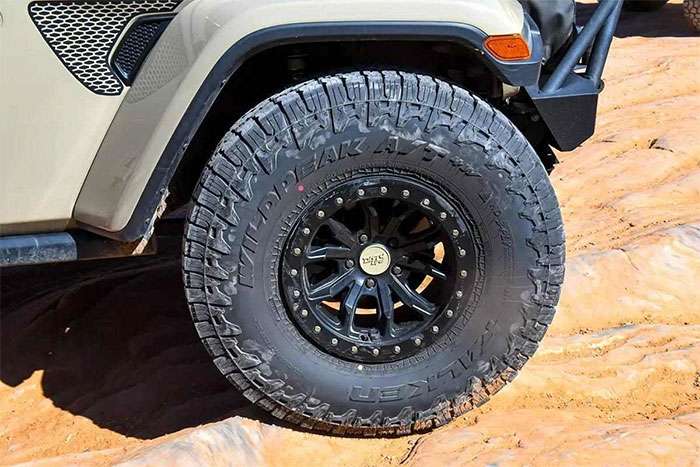
Image Source: Game & Fish
Hybrid off-road tires have emerged as innovative solutions for drivers who refuse to choose between on-road comfort and off-road capability. These specialized tires fill an important gap in the market by combining the best elements from different tire categories into a single, versatile option.
Hybrid tires deliver unique performance through their thoughtful design that borrows from both all-terrain and mud-terrain technologies. These tires feature several distinctive characteristics:
>Specialized tread designs with closely-packed center patterns for quiet highway driving combined with aggressive shoulder lugs for off-road traction
Reinforced sidewall protection using 3-ply construction that resists punctures, abrasions, and tearing
Stone ejectors integrated into the tread pattern to prevent debris buildup and maintain consistent performance
Advanced rubber compounds engineered to balance on-road comfort with off-road durability
Many hybrid models like the Nitto Ridge Grappler incorporate "dynamic hybrid tread pattern" technology specifically designed to reduce road noise while maintaining aggressive off-road capability. These tires typically offer deeper tread depths than all-terrain options while remaining less extreme than dedicated mud-terrains.
Pros:
Enhanced grip compared to all-terrain tires without sacrificing daily drivability
Quieter highway performance than mud-terrain tires due to optimized tread patterns
Better fuel economy than aggressive mud-terrain options - up to 15% improvement in some cases
Improved stability from higher rubber ratio and denser tread design
Superior daily driving experience compared to mud-terrain alternatives
Cons:
Heavier construction than all-terrain and traditional tires affects handling
Limited performance in extreme winter conditions - dedicated winter tires recommended for severe snow
Smaller size selection since hybrid technology is relatively new to the market
Higher cost than entry-level all-terrain options
Less specialized than dedicated terrain-specific tires
Hybrid off-road tires occupy the mid to premium price range, typically costing $196 to $313 per tire. Several popular options include:
Falken Wildpeak R/T: Starting around $313 with 50,000-mile warranty and road hazard protection
Fury Country Hunter R/T: Beginning at $196 with thick tread design
Goodyear Wrangler DuraTrac: Starting at $269 with 50,000-mile warranty and Durawall technology
Toyo Open Country R/T: From $243 with 45,000-mile warranty and multi-terrain optimization
These prices reflect the advanced engineering and specialized materials used in hybrid designs, positioning them between standard all-terrains and premium mud-terrain options.
Hybrid tires excel for specific driving scenarios:
Vehicles splitting time equally between highway and off-road environments
Drivers wanting more grip than all-terrain tires without mud-terrain compromises
Truck owners seeking aggressive appearance with better on-road manners
Off-road enthusiasts needing versatile performance across mud, dirt, sand, and pavement
Daily drivers requiring enhanced traction in variable weather conditions
Understanding hybrid tire capabilities helps you determine if they match your driving needs. These tires eliminate the traditional compromise between on-road comfort and off-road performance, making them ideal for drivers who demand versatility without sacrificing capability in either environment.
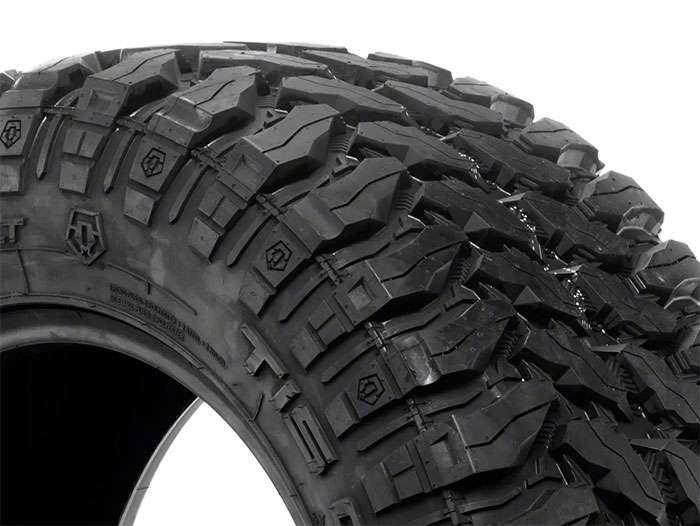
Image Source: Extreme Terrain
When standard mud-terrain tires aren't enough for your most challenging adventures, extreme mud-terrain tires deliver the ultimate solution. These specialized tires represent the most aggressive category in the off-road tire family, designed specifically for conquering terrain that stops other options cold.
Extreme mud-terrain tires push aggression to the maximum with several specialized design elements:
Massive side lugs with 3-ply sidewall construction providing superior protection against punctures and sidewall damage in rocky terrain
Extraordinarily high void ratio between tread blocks that efficiently clears mud and dirt from the pattern, maintaining traction in extreme conditions
Advanced compounds like Krawl-TEK that enhance grip on rock and slick surfaces, delivering up to 8% better traction
Self-cleaning design with "Mud-Phobic" bars on the shoulders specifically engineered to release compacted mud
Unique esthetic options including dual sidewall designs allowing owners to choose their preferred look â€" such as lizard skin sidewall lugs on one side and plain lugs on the other
Many models feature "Terrain-Attack" tread patterns with enormous tread blocks designed to deliver grip from any angle of approach. The three-ply polyester sidewall construction coupled with high-strength steel belt tread packages substantially improves resistance to punctures.
Pros:
Unrivaled traction in mud, rocks, sand, and loose terrain
Superior puncture resistance from reinforced sidewalls
Excellent self-cleaning capabilities
Maximum performance in deep mud conditions
Impressive durability against trail hazards
Cons:
Notoriously louder than even standard mud-terrain tires
Significantly reduced fuel economy due to increased weight and rolling resistance
Shorter tread life, averaging 20,000-30,000 miles at best
Atrocious braking performance on pavement according to user reviews
Poor traction on wet roads despite excelling in off-road mud
Manufacturers typically do not offer limited tread life warranties
Extreme mud-terrain tires represent the premium segment of the off-road market, typically ranging from $300-$500 per tire depending on size, brand, and load rating. Top models from specialized manufacturers may command even higher prices for larger sizes suited for lifted trucks.
Popular options include the Nitto Mud Grappler, BFGoodrich Mud-Terrain T/A KM3, Toyo Open Country M/T, and Cooper Discoverer STT Pro. These premium selections justify their higher cost through specialized construction and materials designed for maximum off-road capability.
These specialized tires excel in specific scenarios where maximum off-road performance is essential:
Hardcore off-roaders who regularly tackle the most challenging terrain
Vehicles with lift kits providing extra ground clearance
Drivers willing to sacrifice on-road comfort for maximum off-road capability
Enthusiasts who "air down" to approximately 10 psi for rock crawling
Show trucks and adventure rigs requiring both performance and aggressive esthetics
These tires perform exceptionally well in mud, rocks, gravel, and sand but struggle significantly on paved roads and in rainy conditions. They're ideal for enthusiasts who spend the majority of their driving time off-road rather than commuting on highways.
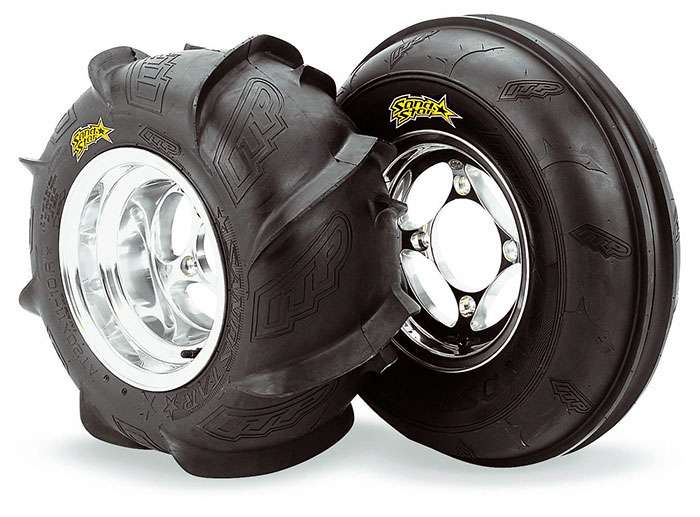
Sand tires represent the ultimate specialized solution for desert adventures and dune conquering. These purpose-built tires excel exclusively in sandy environments where conventional off-road tires simply can't deliver the flotation and traction needed.
Sand tires incorporate unique design elements specifically engineered for desert performance:
Wide footprint that distributes vehicle weight evenly across sand, creating essential "flotation" that prevents sinking
Front and rear tire differentiation with ribbed front designs for steering control and paddle-like rear treads for maximum propulsion
Specialized tread patterns featuring larger gaps between blocks that efficiently clear sand without clogging
Lower pressure capability allowing operation at 12-15 psi for optimal sand performance
The tread design appears less aggressive than rock crawling tires, but this approach prevents excessive digging into soft surfaces. This specialized engineering makes sand tires highly effective in their intended environment.
Pros:
Superior flotation on soft sand surfaces
Exceptional traction in loose desert conditions
Navigate dunes that would trap vehicles with standard tires
Enhanced handling and control in sandy terrain
Cons:
Extremely limited versatility beyond sand environments
Unsuitable for daily driving or highway use
Requires specialized wheels, often beadlocks, for optimal performance
Necessitates carrying air compressors for pressure adjustments between terrain types
Sand tires command premium prices due to their specialized construction. Entry-level options start around $250-$300, while premium models can exceed $850 per tire. Popular options include:
Sand Tires Unlimited Razor Back (10.50 x 17): $430
Sand Tires Unlimited Desert Trak (12.00 x 15): $385
Premium options like Padla Trak (16.50 x 15): $850
Complete specialized sand tire packages with beadlock wheels often exceed $4000, reflecting the premium nature of this specialized equipment.
Sand tires deliver unmatched performance in specific applications:
Dedicated dune riding in locations like Glamis or expansive desert environments
Side-by-side vehicles and UTVs operating primarily in sandy conditions
High-powered off-road vehicles requiring maximum sand traction
Competitive desert racing where specialized performance justifies the investment
Casual desert adventurers can use traditional all-terrain or mud-terrain tires at reduced pressure (8-12 psi), though performance will be notably inferior compared to dedicated sand tires. For serious sand riding, specialized sand tires remain the only viable option for optimal performance and safety.
Winter conditions demand specialized off-road tires that maintain grip when temperatures drop and trails turn treacherous. Snow and ice off-road tires are engineered specifically for cold-weather performance where standard off-road options lose their effectiveness.
Winter off-road tires use specialized rubber compounds that stay flexible below 7°C, ensuring consistent traction when other tires become rigid and lose grip. Key design elements include:
Deep, wide grooves that efficiently evacuate snow and slush from the contact patch
Hundreds of small sipes (tiny slits) that create additional biting edges for enhanced ice traction
3-Peak Mountain Snowflake (3PMSF) certification, confirming the tire meets rigorous winter performance standards
These specialized tread patterns are specifically designed to bite into snow and ice, delivering superior control compared to standard off-road tires in freezing conditions.
Pros:
Exceptional traction on snow and ice surfaces
Improved braking performance in winter conditions
Enhanced steering control on slippery terrain
Cons:
Limited effectiveness beyond winter conditions
Requires seasonal tire changes for optimal performance
Specialized compounds wear more quickly in warm temperatures
Winter off-road tires range from approximately $115 to $330+ per tire. Notable options include:
Toyo Celsius: Starting at $115.35 featuring snow claws and slush grooves
Michelin Pilot Alpin PA5: Starting at $331.18 with advanced cold-weather compounds
These specialized tires are essential for drivers in regions experiencing freezing temperatures (below 7°C) or significant snowfall. Unlike all-terrain or mud-terrain alternatives, winter off-road tires maintain flexibility and grip on icy surfaces, making them crucial for safe winter driving when trails become hazardous.
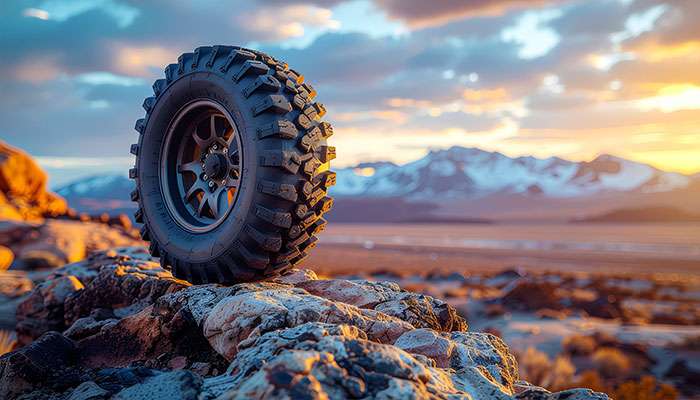
Rock crawling tires represent the ultimate specialized solution for tackling the most technical rocky terrain. These purpose-built options deliver maximum grip and durability when standard off-road tires simply can't handle slick rock faces and challenging obstacles.
Rock crawling tires are engineered with specific design elements that set them apart from other off-road options:
Soft rubber compounds with durometer ratings around 42-48 that conform to rock surfaces for maximum grip
Reinforced sidewalls featuring additional protection against sharp edges and punctures
Sidewall lugs delivering extra traction when navigating obstacles at steep angles
Low pressure capability allowing operation at 10-13 PSI to create wider footprints and better rock conformity
Quality rock crawling setups often require beadlock wheels that mechanically clamp the tire to prevent slippage at these extremely low pressures.
Pros:
Exceptional grip on slick rock surfaces
Superior puncture resistance from reinforced construction
Outstanding conformity to uneven terrain
Maintains traction at extreme angles
Cons:
Poor highway performance and comfort
Reduced fuel economy
Heavier construction than standard tires
Requires frequent pressure adjustments and maintenance
Rock crawling tires occupy the premium end of the specialized tire market, typically ranging from $230-$500 per tire. Popular options like the BFGoodrich Krawler T/A KX command top prices due to their specialized construction and materials designed for extreme rock performance.
These specialized tires excel in specific scenarios where maximum rock traction is essential:
Technical rock obstacles requiring precise grip and control
Uneven boulder fields where conformity is crucial
Slick rock surfaces that challenge standard off-road tires
Competitive rock crawling where performance outweighs versatility
Dedicated trail rigs operating primarily in rocky terrain
Rock crawling tires are purpose-built for enthusiasts who prioritize maximum rock performance over everyday driving comfort.
Understanding the differences between off-road tire types helps you make the right choice for your specific driving needs. We've created this comparison table to help you quickly evaluate each tire type based on key factors that matter most to your off-road adventures.
| Tire Type | Key Features | Best Use Cases | Price Range (per tire) | Main Advantages | Main Disadvantages | Typical Tread Life |
|---|---|---|---|---|---|---|
| All-Terrain (A/T) | Reinforced sidewalls, interlocking tread elements, all-season capability | 60% on-road, 40% off-road; daily drivers with occasional off-road use | $200-$400 | Versatility across multiple terrains, better fuel efficiency than M/T | Noisier than highway tires, stiffer ride | 45,000-65,000 miles |
| Mud-Terrain (M/T) | Deep aggressive lugs, mud-phobic bars, 3-ply sidewalls | 50%+ off-road use, rock crawling, deep mud conditions | $300-$500 | Exceptional off-road traction, superior self-cleaning | Significantly noisy on-road, poor wet pavement performance | 35,000-45,000 miles |
| Rugged-Terrain (R/T) | Balanced tread design, strong sidewalls, aggressive shoulder lugs | 50/50 on/off-road split, frequent towing | $200-$400 | Better off-road grip than A/T, quieter than M/T | Heavier than A/T, limited size availability | 50,000-60,000 miles |
| Hybrid Off-Road | Specialized tread designs, 3-ply construction, stone ejectors | 50/50 on/off-road split, daily drivers needing enhanced traction | $196-$313 | More grip than A/T, quieter than M/T | Heavier than traditional tires, limited winter performance | 45,000-50,000 miles |
| Extreme M/T | Massive side lugs, high void ratio, 3-ply sidewalls | Hardcore off-roading, lifted trucks, rock crawling | $300-$500+ | Unrivaled off-road traction, superior puncture resistance | Extremely loud, poor fuel economy | 20,000-30,000 miles |
| Sand Tires | Wide footprint, specialized front/rear designs, paddle-like treads | Dedicated dune riding, desert environments | $250-$850 | Superior sand flotation, exceptional desert traction | Extremely limited versatility, not suitable for daily driving | Varies by use |
| Snow/Ice Off-Road | Deep wide grooves, multiple sipes, 3PMSF certification | Winter conditions, freezing temperatures | $115-$330 | Superior winter traction, better cold-weather braking | Limited use beyond winter, faster wear in warm weather | 40,000-50,000 miles |
| Rock Crawling | Soft rubber compounds, reinforced sidewalls, sidewall lugs | Technical rock obstacles, boulder fields | $230-$500 | Superior rock grip, enhanced puncture resistance | Poor on-road performance, reduced fuel efficiency | 25,000-35,000 miles |
When selecting your off-road tires, focus on the "Best Use Cases" column to match your driving habits. Consider your typical split between on-road and off-road driving, then factor in your budget and expected tread life.
For most drivers, all-terrain or rugged-terrain options provide the best balance of performance and value. Specialized tires like sand or rock crawling options excel in specific conditions but require careful consideration of their limitations.
At Performance Plus Tire, we carry the best selection of all these off-road tire types at competitive prices. Our expert fitment team can help you choose the right option based on your vehicle specifications and driving needs.
Selecting the right off-road tires comes down to understanding your specific driving needs and terrain challenges. We've covered eight distinct tire types, each engineered for different off-road scenarios. Your ideal choice depends on how you split time between pavement and trails.
Highway drivers with occasional weekend adventures should consider all-terrain or rugged terrain options. These versatile performers deliver solid off-road capability without sacrificing daily driving comfort. Serious off-road enthusiasts tackling extreme conditions will benefit from specialized mud-terrain or rock crawling tires that prioritize maximum traction over road comfort.
Weather conditions play a crucial role in your selection process. Snow and ice demand specialized winter compounds, while desert adventures require dedicated sand tires for optimal performance. Budget considerations should include both upfront costs and long-term value, as tread life varies significantly between categories.
Hybrid and rugged-terrain options strike the best balance for mixed-use vehicles. These newer categories bridge the gap between traditional all-terrain versatility and mud-terrain aggression, offering excellent performance across diverse environments.
You can find all the different types of off-road tires at discount prices at Performance Plus Tire, making it easier to get the right rubber for your specific needs without breaking the bank.
No single tire excels at everything. The perfect choice balances your specific driving needs, budget constraints, and performance expectations. Armed with this guide, you can confidently select the ideal off-road tires to make your next adventure extraordinary.
Understanding the eight types of off-road tires helps you match your specific driving needs with the right rubber for optimal performance and safety.
• All-terrain tires offer the best balance for drivers splitting 60% highway/40% off-road time, providing versatility without major compromises • Mud-terrain tires excel in extreme conditions but sacrifice on-road comfort, fuel economy, and tread life for maximum off-road capability • Rugged-terrain and hybrid tires bridge the gap between A/T and M/T options, ideal for 50/50 on/off-road driving splits • Specialized tires like sand, snow, and rock crawling deliver superior performance in specific conditions but lack versatility • Price ranges from $115-$850 per tire depending on type and brand, with tread life varying dramatically from 20,000-65,000 miles
The key to choosing the right off-road tire lies in honestly assessing your driving habits, terrain challenges, and budget constraints. No single tire excels at everything, so prioritize the features that matter most for your specific adventures.
All-terrain tires offer a balance of on-road comfort and off-road capability, ideal for vehicles that split time between highways and trails. Mud-terrain tires excel in extreme off-road conditions but sacrifice on-road performance and fuel efficiency.
Hybrid off-road tires bridge the gap between all-terrain and mud-terrain tires. They offer better off-road grip than all-terrains while providing a quieter ride than mud-terrains, making them suitable for drivers who split time equally between on and off-road environments.
Specialized tires like sand or rock crawling options deliver superior performance in specific conditions but lack versatility. They're worth the investment if you frequently tackle those particular terrains, but may not be practical for general use.
Rugged terrain tires feature more aggressive tread patterns than all-terrains, offering enhanced off-road capability without sacrificing too much on-road comfort. They're ideal for drivers needing a bit more off-road performance than standard all-terrains provide.
When selecting off-road tires, consider your driving habits, typical terrain, weather conditions, and budget. Factor in both initial cost and long-term value, as tread life varies significantly between tire types. Balancing your specific needs with tire performance characteristics will help you make the best choice.